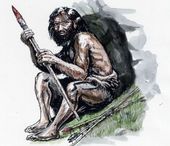
© UnknownBack from the dead?: Scientists could potentially revive man's closest relative.
Neanderthals are a step closer to walking on Earth again.
Scientists have unravelled the genetic code of man's closest cousin using fragments of bone found across Europe.
The blueprint could provide information on the Neanderthal's looks, intelligence, health and habits, as well as what makes us human.
It also raises the intriguing possibility of bringing our ancient relatives, who died out around 30,000 years ago, back from the dead.
Researcher Professor Jean-Jacques Hublin said: 'Studying the Neanderthals and studying the Neanderthal genome will tell us what makes modern humans really human, why we are alone, why we have these amazing capabilities that allowed our ancestors to draw paintings, to create complex symbols.'